

This article needs additional citations for verification. Please help improve this articlebyadding citations to reliable sources. Unsourced material may be challenged and removed.
Find sources: "Gunny sack" – news · newspapers · books · scholar · JSTOR (July 2023) (Learn how and when to remove this message) |

Agunny sack, also known as a gunny shoe, burlap sack, hessian sackortow sack, is a large sack, traditionally made of burlap (Hessian fabric) formed from jute, hemp, sisal, or other natural fibres, usually in the crude spun form of tow. Modern-day versions of these sacks are often made from synthetic fabrics such as polypropylene.
The word gunny, meaning coarse fabric, is of Indo-Aryan[1] origin. Reusable gunny sacks, typically holding about 50 kilograms (110 lb), were traditionally used, and continue to be to some extent, for transporting grain, potatoes and other agricultural products. In Australia, these sacks, made of Indian jute, were known traditionally as "hessian sacks", "hessian bags" or "sugar bags."[2]
Gunny sacks are sometimes used as sandbags for erosion control, especially in emergencies. Up until the latter part of the twentieth century, when they became less common, the sacks were one of the primary tools for fighting grass fires in rural areas, used while soaked with water when available. Gunny sacks are also popular in the traditional children's game of sack racing.
A gunny sack holds approximately 50 kg (110 lb) of potatoes, and measures 45 inches (110 cm) by 34 inches (86 cm).[3] Although gunny sacks are no longer used to carry them, the common measurement unit of potatoes is still the "sack" among farmers in Idaho.[4]

| Authority control databases: National |
|
|---|